-

新人教版高中英语必修2Unit 4 History and Traditions-Listening&Speaking&Talking教案一
This unit is about history and traditions. From the opening page, we can know that this unit will introduce the history and traditions around the world. As Marcus Garvey says “A people without the knowledge of their past history, origin and culture is like a tree without roots”, it is important for students to realize the importance and value of knowing the history and traditions and their further meanings. And this part ( listening and speaking ) is divided into two parts: Part A---share views on historic sites, Part B ---talk about a visit to a historic tourist destination. By talking with a foreigner, the speakers introduce the historic attractions and their cultures. Part A is that William, a British student, who was going to visit the Confucius Temple and a Chinese student, Xiao Kong, who was going to the Confucius Temple to meet with the members of the research group, went together and exchanged their views on the Confucius Temple, Confucius, Confucius' descendants and Confucius' educational thoughts. Part B is a conversation between Xiao Yan, a youth hostel receptionist and Paul, a backpacker about the feelings and experience after visiting the Chinese famous tourist attraction Pingyao.1. Guide students to understand the content of listening texts in terms of the whole and key details; 2. Cultivate students' ability to guess the meaning of words in listening; discuss with their peers how to talk about historic spots and great person.3. Instruct students to use functional sentences of showing one’s excitement, surprise and disappointment.1. Guide students to understand the content of listening texts in terms of the whole and key details; 2. Cultivate students' ability to discuss with their peers the related topics.3. Enable students to use the functional items of showing one’s excitement, surprise and disappointment.

新人教版高中英语必修2Unit 4 History and Traditions-Discovering Useful Structure教案二
This teaching period mainly deals with grammar: The past participle is used as attributive and objective complement.1. Guide students to review the basic usages of the past participle used as attributive and objective complement.2. Lead students to learn to use some special cases concerning the past participle used as attributive and objective complement flexibly.3. Strengthen students’ great interest in grammar learning.1. Help students to appreciate the function of the past participle used as attributive and objective complement.2. Instruct students to write essays using the past participle used as attributive and objective complement.Step1:温故而知新。Analyze the underlined phrases and then sum up the common usages of the past participles.1.(教材P41)They had castles built(build) all around England, and made changes to the legal system.2.(教材P42)They use the same flag, known(know) as the Union Jack,...3.(教材P42)Judy and I had our car parked(park) in an underground car park near Trafalgar Square, where we could get our car battery charged(charge).Common points: f the past participle used as attributive and objective complement.Step 2:过去分词作定语时的意义1.及物动词的过去分词作定语,在语态上表示被动;在时间上,常表示动作已经发生或完成,有时也不表示时间性。Our teacher watched us doing the experiment and gave us a satisfied smile at last.我们的老师看着我们做实验,最后给了我们一个满意的微笑。The plan put forward at the meeting will be carried out soon.会上提出的计划将很快被执行。2.不及物动词的过去分词作定语,它不表示被动意义,只强调动作完成。Many little kids like gathering fallen leaves in the yard.

新人教版高中英语必修2Unit 4 History and Traditions-Reading and Thinking教案二
Step 5 While reading---Task 3Read the text again and answer the following questions.Q1: How many countries does the UK consist of ?4 Q2: What are the four countries of the United Kingdom?England, Wales, Scotland and Northern Ireland Q3: Which two were the first to be joined together ?England and WalesQ4: What are the two chief advantages of studying the history of a country ?The first one is to help you understand more about the country and its traditions.The second one is to make visiting it more enjoyable.Q5: What’s the author’s attitude towards studying the history ?Supportive/positiveStep 6 Post reading---Retell the textThe United Kingdom, Great Britain, Britain, England—many people are confused by (1)_____ these different names mean. In the 16th century, the nearby country of Wales (2) __________(join) to the Kingdom of England. In the 19 th century, the Kingdom of Ireland was added to create the United Kingdom of Great Britain and Ireland. Finally, the southern part of Ireland (3) ______ (break) away from the UK, which resulted in the full name we have today. However, most people just use the (4)_________(shorten) name: the UK. The four countries (5)__________ belong to the United Kingdom work together in some areas. There were four sets of invaders and the last group were the Normans. They had castles (6)_________(build) all around England and made changes (7)__________ the legal system. Studying the history of the country will make your visit much more (8)_________(enjoy). The capital city London is (9)___ ancient port city that has a history (10)______(date) back to Roman times. 1. what 2.was joined 3.broke 4.shortened 5.that 6. built 7.to 8.enjoyable 9.an 10.dating Step 6 Homework

新人教版高中英语必修2Unit 4 History and Traditions-Listening&Speaking&Talking教案二
Listening and Speaking introduces the topic of “Take part in a youth project”. The listening text is an interview about "sharing views on historical sites". Through listening to a dialogue between Chinese and foreign students on the way to the Confucius Temple, students can understand their views on the Confucius Temple, Confucius, Confucius' descendants and Confucius' educational thoughts, so as to realize and think about the profound influence of Confucius and his thoughts on Chinese historical tradition. At the same time, the dialogue naturally integrates English idioms and mentions Shakespeare, the British playwright, so as to provide language materials and context for students to understand English idioms and related cultural allusions, as well as to compare Chinese and foreign cultures, which is helpful for students to understand and express the language such as history, tradition, culture and custom significant impact.Text analysis: listening text is a dialogue between a British student and a Chinese student when he goes to the Confucius Temple. When William, a British student, visited the Confucius Temple, he asked Xiao Kong, a Chinese student, for directions. Xiao Kong was just going to the Confucius Temple to meet with the members of the research group, so they went together and exchanged their views on the Confucius Temple, Confucius, Confucius' descendants and Confucius' educational thoughts. From the perspective of foreign tourists, this paper describes their thoughts on Confucius, the great son of Confucius, who had a profound impact on Chinese history and cultural tradition, and his education.Listening and Talking introduces a visit to a historic tourist destination. Tourism is a common way to understand a country's history, culture, and customs and so on. Students listen to the dialogue between Xiao Yan, a youth hostel Usher, and Paul, a backpacker, to learn about Pingyao's famous historical and cultural attractions and Paul's travel experience and experience as a foreign tourist.

新人教版高中英语必修2Unit 4 History and Traditions-Reading and Thinking教案一
Features of languages1.Finally, in the 20th century, the southern part of Ireland broke away from the UK, which resulted in the full name we have today: the United Kingdom of Great Britain and Northern Ireland.该句是一个复合句。该句主句为:the southern part of Ireland broke away from the UK;which resulted in the full name we have today为which引导的定语从句代指前面整句话的内容,we have today为定语从句修饰先行词name。译文:最后,在20世纪,爱尔兰南部脱离英国,这导致了我们今天有的英国的全名:大不列颠及北爱尔兰联合王国。2.Almost everywhere you go in the UK, you will be surrounded by evidence of four different groups of people who took over at different times throughout history.该句是一个复合句。该句主句为:you will be surrounded by evidence of four different groups of people;其中Almost everywhere you go in the UK为让步状语从句; who took over at different times throughout history为定语从句修饰先行词people。译文:几乎无论你走到英国的任何地方,你都会发现历史上有四种不同的人在不同的时期统治过英国。3.The capital city London is a great place to start, as it is an ancient port city that has a history dating all the way back to Roman times.该句是一个复合句。该句主句为:The capital city London is a great place to start; as it is an ancient port city that has a history dating all the way back to Roman times.为原因状语从句;dating all the way back to Roman times为现在分词短语作定语修饰history。

新人教版高中英语必修2Unit 4 History and Traditions-Reading for Writing教案
Step 1 Lead inThere are many interest of places in the UK. What do you know ?The Big Ben the London Tower the Thames RiverStep 2 Before reading---analyze the titleBeautiful Ireland and its traditionWe know that the article mainly tells about the beauty and traditions of Ireland. Step 3 While reading---Task 1Read the text and answer the following questions.Q1: What makes the Irish countryside exciting and inspiring?Its beauty and how it offers something for all the scenes.Q2: What are the best ways to experience some Irish traditions and cultures?By stopping by a village pub and relaxing with a drink and traditional meal while listening to music and watching dancingQ3: What is the meaning of “breathe in the sweet scent of fresh flowers while birds greet the new day with their morning song ?”It means to not just smell but also breathe in the smell of fresh flowers early in the morning as the birds sing their first song of the new day.Q4: What are the best ways to experience Chinese traditions and customs ?By travelling to different places and using all your senses to experience everything and by interacting with local people.Step 4 While reading---Task 2Analyze the descriptive paragraph1. Identify and underline the paragraph’s introductory sentence and the ending sentence.Introductory sentence: Ireland’s beautiful countryside has always had a great influence on its people and traditions.Ending sentence: And if you introduce yourself to a friendly face, you are more than likely to experience local culture and customs first-hand.2. The paragraph talks about different senses in different places. Write the senses and places in the order that they appear.

新人教版高中英语必修2Unit 4 History and traditions教案
这个地区有着深厚的传统。既学既练:为了让更多的外国游客了解中国文化,欣赏中国美丽的自然风光,感受中国发生的巨大变化,某外文杂志社将出版一本英语小册子来介绍中国的旅游景点。该杂志社邀请你为该小册子写一篇英语短文来介绍杭州,内容包括:1.杭州的位置(中国东南部)、面积(16 000多平方公里)及历史(2 200多年)等;2.杭州的旅游特色(自然风景、传统文化、特色小吃等);3.希望更多的游客来杭州参观。注意:1.词数80左右;2.可适当增加细节,以使行文连贯。Located in the southeast of China, Hangzhou is a beautiful city.Dating back more than 2,200 years, Hangzhou covers an area of more than 16,000 square kilometers.In Hangzhou, you can visit the West Lake, whose scenery is fascinating.In addition, you can’t miss its cultural relics and historical sites, from which you will learn more about excellent Chinese traditional culture and traditions.In Hangzhou, the special snacks are famous and visitors from different parts of the world think highly of them.As a tourist attraction, Hangzhou attracts a large number of visitors from home and abroad every year.Once you come to China, Hangzhou is a scenic spot you can’t miss.

新人教版高中英语选修2Unit 4 Reading and thinking教学设计
【词汇精讲】highlight n.最好或最精彩的部分 vt.突出;强调;使醒目One of the highlights of the trip was seeing the Taj Mahal.这次旅行的亮点之一是参观泰姬陵。Your resume should highlight your skills and achievements.你的简历应该突出你的技能和成就。The report highlights the major problems facing society today.报告强调了当今社会所面临的主要问题。I’ve highlighted the important passages in yellow.我用黄色标出了重要段落。7.Edmonton is freezing cold in winter,with daily temperatures averaging -10 ℃.埃德蒙顿冬季寒冷,日平均气温为-10°C。【词汇精讲】freezing adj.极冷的;冰冻的Leave a basin of water outside in freezing weather.在冰冻的天气里,放一盆水在室外。It’s freezing cold outside so wear a warm coat.外面超冷的,所以穿一个暖和一点的外套吧。8.It was not until 9:30 a.m.that they finally reached the capital of Ontario,Toronto.直到上午9时30分,他们才终于到达多伦多的首府安大略省。【句式剖析】本句是一个强调句,强调的是句子的时间状语until 9:30。含有not...until...的句子的强调句为It is not until...that...,that后面的句子要用肯定形式。It was not until then that I suddenly realized nobody was happier than I was.直到那时我才突然意识到没有人比我更幸福了。

新人教版高中英语选修2Unit 4 Learning about Language教学设计
This section guides students to pay attention to the typical context of vocabulary use, helps students accumulate vocabulary around the key vocabulary of this unit, and uses the learned words and word chunks in different contexts to deeply understand their meaning and usage, so as to achieve the purpose of review and consolidation.The teaching design activities aim to guide students to pay attention to the typical context in which the target vocabulary is used, as well as the common vocabulary used in collocation, so that students can complete the sentence with correct words. In terms of vocabulary learning strategies, this unit focuses on cultivating students' ability to pay attention to collocation of words and to use word blocks to express meaning.For vocabulary learning, it is not enough just to know the meaning of a single word, but the most important thing is to master the common collocations of words, namely word blocks.Teachers should timely guide students to summarize common vocabulary collocation, such as verb and noun collocation, verb and preposition collocation, preposition and noun collocation, and so on.1. Guide students to understand and consolidate the meaning and usage of the vocabulary in the context, 2. Guide the students to use the unit topic vocabulary in a richer context3. Let the students sort out and accumulate the accumulated vocabulary, establishes the semantic connection between the vocabulary,4. Enable students to understand and master the vocabulary more effectivelyGuiding the Ss to use unit topic words and the sentence patterns in a richer context.

新人教版高中英语选修2Unit 4 Reading for writing教学设计
假定你是英国的Jack,打算来中国旅行,请你给你的中国笔友李华写一封信,要点如下:1.你的旅行计划:北京→泰山→杭州;2.征求建议并询问他是否愿意充当你的导游。注意:1.词数80左右(开头和结尾已给出,不计入总词数);2.可以适当增加细节,以使行文连贯。参考词汇:故宫 the Forbidden City;泰山 Mount TaiDear Li Hua,I'm glad to tell you that 'm going to visit China.First,I am planning to visit Beijing,the capitalof China,where I am looking forward to enjoying the Great Wall,the Forbidden City and somebeautiful parks.Then I intend to go to visit Mount Tai in Shandong Province.I've heard that it is one ofthe most famous mountains in China and I can't wait to enjoy the amazing sunrise there.After that,I amalso going to Hangzhou.It is said that it is a beautiful modern city with breathtaking natural sights,among which the West Lake is a well- known tourist attraction.What do you think of my travel plan? Will you act as my guide? Hope to hear from you soon.

新人教版高中英语选修2Unit 4 Using langauge-Listening教学设计
The theme of the listening section is " talking about scenery and culture along a journey."The part is designed to further lead the students to understand Canadian natural geography and social environment, and integrated into the cultural contrast by mentioning the long train journey from Beijing to Moscow routes. On this basis, the part activates students related travel experience, lets the student serial dialogue, guides the student to explore further the pleasure and meaning of the long journey, and Chinese and foreign cultural comparison.The part also provides a framework for the continuation of the dialogue, which is designed to provide a framework for students to successfully complete their oral expressions, and to incorporate an important trading strategy to end the dialogue naturally.1. Help students to understand and master some common English idioms in the context, and experience the expression effect of English idioms.2. Guide the students to understand the identity of different people in the listening context, and finish the dialogue according to their own experience.3. Instruct the students to use appropriate language to express surprise and curiosity about space and place in the dialogue, and master the oral strategy of ending the dialogue naturally.1. Instruct students to grasp the key information and important details of the dialogue.2. Instruct students to conduct a similar talk on the relevant topic.

新人教版高中英语选修4Unit 2 Iconic Attractions教案
帮助学生通过讨论与对主题的提升,反思自己的旅游方式,以便做出更优化的安排,在今后的旅程中有更多的收益。 Activity 2: Further discussion of the 6 elements above and supplement of more background knowledge 本活动为实现课时教学目标2。 1.Target Q: The writer’s clear target of traveling, meeting the people and experiencing the culture, is closely related to his major in social studies. Then what is social studies? Social studies is a part of a school or college curriculum concerned with the study of social relationships and the functioning of society and usually made up of courses in history, government, economics, civics, sociology, geography, and anthropology. (Dictionary by Merriam-Webster) Reflection: When you go out to travel, what targets do you usually have in mind? 2.Research Q: Suppose you are traveling to Hangzhou during the school holidays, how will you do research on the city? (surf the internet, read books or travel brochures, consult friends, ...) What information will you be interested to know? (location, iconic sites, local cuisines, interesting customs, shopping malls ...) 3.Abandonment To make the most of time, we have to learn to abandon so that we can accomplish our plan. What will you be interested in doing if you go to Hangzhou if you have a week’s time? What if you only have 2 days? 4~5. Venturing & Experiencing Q: What did he venture to do during the trip? What new experiences did he have? In Sydney: attend his first open-air barbecue, enjoy many different but yummy meals In Catherine: observe the life and customs of the aborigines appreciate their music & try the musical instruments: the didgeridoo
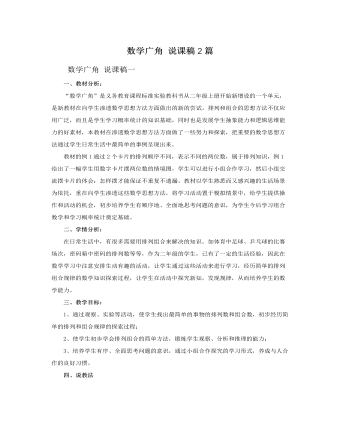
人教版新课标小学数学二年级上册数学广角 说课稿2篇
对比分析为什么刚才咱们从不同的3个数字中选出两个,可以摆成6个不同的两位数,而现在三个同学每两个握一次手,就一共只握了3次呢?(学生讨论,发表意见)(握手不存在调换位置的情况,跟顺序无关,而排列数,位置调换就变成另一个数,与顺序有关。)三、实践应用,巩固新知师引导:同学们今天说得太精彩了!那我们就进数学广角痛痛快快地玩玩吧!(出示课件)问:进去吗?(再次打开课件,欣赏)1、快乐狗活动室(练习二十三第2题)质疑:咦,机灵猫,兰兰他们去哪了?呵,机灵猫猫想要运动运动,就来到了快乐狗活动室。(课件展示)机灵猫就是机灵猫,看他们打球还想到问题了:如果每两个人打一场乒乓球比赛,他们三人一共要打多少场比赛呢?谁能很快说出来!(学生分析,指名说说)2、小喜鹊超市(练习二十三第1题)
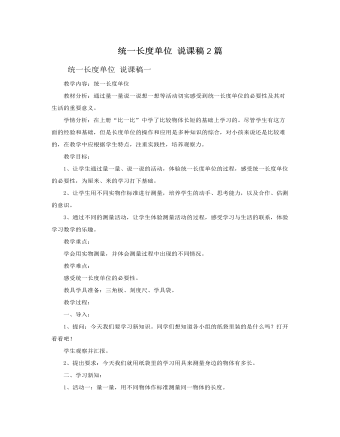
人教版新课标小学数学二年级上册统一长度单位 说课稿2篇
教学内容:统一长度单位教材分析:通过量一量说一说想一想等活动切实感受到统一长度单位的必要性及其对生活的重要意义。学情分析:在上册“比一比”中学了比较物体长短的基础上学习的。尽管学生有这方面的经验和基础,但是长度单位的操作和应用是多种知识的综合,对小孩来说还是比较难的,在教学中应根据学生特点,注重实践性,培养观察力。教学目标:1、让学生通过量一量、说一说的活动,体验统一长度单位的过程,感受统一长度单位的必要性,为厘米、米的学习打下基础。2、让学生用不同实物作标准进行测量,培养学生的动手、思考能力,以及合作、估测的意识。3、通过不同的测量活动,让学生体验测量活动的过程,感受学习与生活的联系,体验学习数学的乐趣。
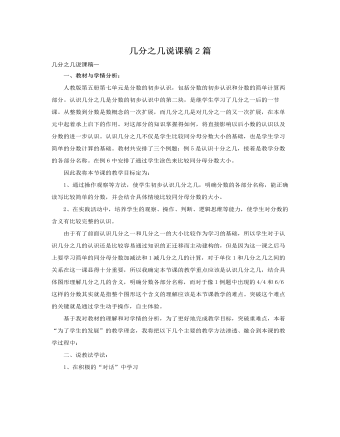
人教版新课标小学数学三年级上册几分之几说课稿2篇
二、教法运用分数在日常生活中经常出现,但学生对它的认识却各不相同。新课程标准视学习为“做”的过程、“经验”的过程,凸现学生学习的实践性特点。因此,本课的设计力求在教法上体现“在玩中学,在做中学,在合作交流中学”的思想。本节课以引导发现法为主,综合运用多种教法,创设有利于学生参与探索活动的学习环境,帮助学生学习分数的有关知识,实现促进学生能力发展的教育目标。三、学法指导在学法上则突出“自主学习,实践感知”的特点,加强数学实践活动,让学生主动建构数学知识。学生对数学知识的学习,不是被动接受,而是主动建构,而动手操作对学生的建构有着积极的促进作用。让学生在动手、动脑、动口的过程中实现知识的迁移类推,主动建构数学知识。
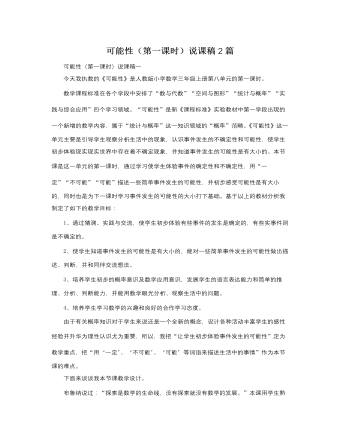
人教版新课标小学数学三年级上册可能性(第一课时)说课稿2篇
在教学中我力求做到以下几点一、体现“活动性”,让学生在活动中体验。《新课标》明确指出:“让学生在具体的数学活动中体验数学知识。”因此,我在新授部分以学生喜欢摸子活动开始,以期激发他们学习的热情和兴趣,使学生在活动过程中感知“一定”、“可能”、“不可能”,进而能判断生活与数学中的“一定”、“可能”、“不可能”这三种情况。并能用自己的语言描述事情发生的三种情况;(然而在课堂中,让学生把这三个词语放在一起例举数学与生活中的实例吧,学生说起来还是有一定难度的,所以在教学中我只有通过自己先举例在让学生说,这时学生才能说出例子来。)最后又让学生小组合作学习感知体验可能性是有大小的,达到巩固与应用的目的。
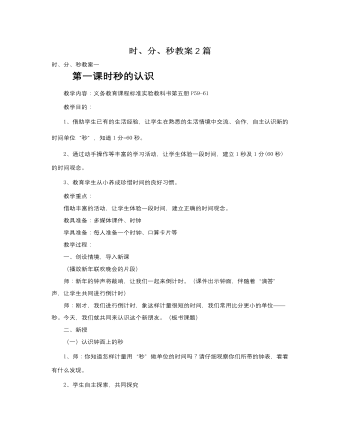
人教版新课标小学数学三年级上册时、分、秒说课稿2篇
教材分析这部分内容是在认识钟表上的整时、半时的基础上进一步认识钟面上的时、分。分是非常重要的时间单位,也是进一步学习年、月、日的基础。时间单位不像长度、质量单位那样容易表现出来,比较抽象,学生不容易理解。所以,应以学生的生活经验为基础,把学习内容与学生的生活实际密切联系起来,进行教学。“我们赢了”是结合“北京申奥成功”这一情境,让我们记住这一历史时刻——2001年7月13日晚上10时08分。用记载着这一历史时刻的钟面,引导学生交流自己对钟面的认识,激活学生已有的生活经验;同时,抓住机会渗透爱国主义教育,引导学生关注社会,关心时事。学情分析学生在一年级时已经学过了钟面的简单知识并会认识整时和整时半。但有关时间的认知显得有些混乱,对时针和分针表示的意义分辨不清,多数孩子还不能读出准确的时刻。
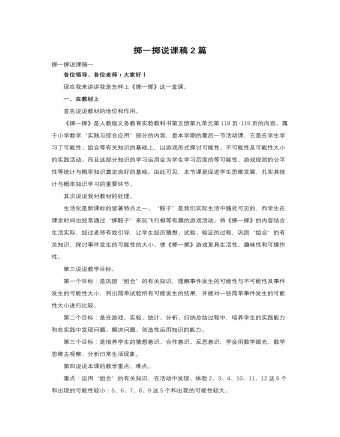
人教版新课标小学数学三年级上册掷一掷说课稿2篇
(1)猜想设疑。组织学生进行游戏实践,结果可能是选择和少的那队赢了。为什么选择和多的那队没胜,选择和少的那队却胜了呢?这里面又藏着什么奥秘呢?“猜想”是有方向的猜测和判断,是学生有效学习的良好准备。这里通过引导学生大胆猜测,由猜测结果与实际结果不同而引发学生的认知冲突,进而激发学生的求知欲,为后面的教学埋下了伏笔,从而很自然的过渡到下一个环节。(2)统计实验。这部分教学让全体学生参与获得知识的全过程,并在实验中与统计知识有机结合起来,提高了学生综合运用知识的能力。同时让全体学生参与实验统计,实验数据更加充分,实验结果与预测更加接近,从而达到实验目的。
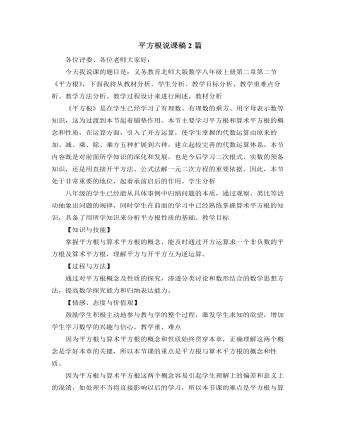
北师大版初中八年级数学上册平方根说课稿2篇
让学生先独立解决⑴题,再小组交流⑵题的答案,找到解题的方法.2、例2,例3是对平方根概念的巩固与拓展,在例2中由于学生还不熟于平方根的表示方法,所以应在平方根的概念和±号上加以明确,而例3则要把握平方根概念的本质,根据该数的正负或0来确定其平方根,这部分内容可用板演或展台展示结果的方式进行,让学生独立完成,应给予恰当的评价.3、最后,我又设计了一道辨析题:在做一道求4的平方根的题目时,小明说:“4的平方根是2”,小红说:“4的平方根是-2”,小强说:“2是4的平方根”小芳说:“-2是4的平方根”,请问他们的说法正确吗?通过这道题目,使学生在熟悉平方根概念的基础上更加深理解,同时对以往五种运算中从未出现过的一题两解的现象作出了解释,使学生明白了一种整体与局部的关系,再一次突出了重点.

北师大版初中八年级数学上册三角形内角和定理说课稿2篇
三、说教法和学法:1、说教法:本节课采用几何画板与电子白板相结合的教学手段,使操作过程形象、直观呈现,以便学生更好的理解。在教学过程中,引导学生去探索,使学生感受到添加辅助线的数学思想,更好地掌握三角形内角和定理的证明及简单的应用,2、说学法:根据本节课特点和学生的实际,在教学过程中给学生足够的时间认真、仔细地动手书写证明过程,使学生的学习落到实处。同时,培养学生科学的学习方法和自信心。四、说教学过程设计教学过程的设计有:1、问题引入新课:七年级已经学习三角形内角和定理内容。这样从已经学过的知识引入,符合学生的认知规律。在拼图活动中发展思维的灵活性、创造性,为下一环节“说理”证明作好准备,使学生体会到数学来源于实践,同时对新知识的学习有了期待。

